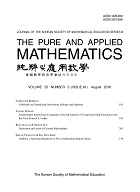3권 1호
초록
Abstract
Since the invention of the Pettis integral over half century ago, the problem of recognizing the Pettis integrability of a function against an individual condition has been much studied [1,6,7,8,12]. In spite of the R.F. Geitz (1982) and M. Talagrand's (1984) characterization of Pettis integrability, there is often trouble in recognizing when a function is or is not Pettis integrable.(omitted)
초록
Abstract
In this paper, we consider the existence of a solution to the elliptic nonlinear partial differential equation <TEX>${\Delta}u+H({\chi})e^{u}$</TEX> = 0 (H <TEX>$\neq$</TEX> 0) (1) on a compact manifold without boundary. This equation is related to the problem of a pointwise conformal deformation of metrics on two dimensional compact connected manifolds.(omitted)
초록
Abstract
A symplectic manifold is a pair (M, <TEX>$\omega$</TEX>) consisting of a smooth manifold M and a non-degenerate closed 2-form <TEX>$\omega$</TEX> on M. Locally, <TEX>$\omega$</TEX> = (equation omitted) and d<TEX>$\omega$</TEX> = 0, when n = dimM. The condition d<TEX>$\omega$</TEX> = 0 implies that locally <TEX>$\omega$</TEX> = d<TEX>${\alpha}$</TEX> with <TEX>${\alpha}$</TEX> = (equation omitted). There are three main sources of symplectic manifolds.(omitted)
초록
Abstract
A convergence structure defined by Kent [4] is a correspondence between the filters on a given set X and the subsets of X which specifies which filters converge to points of X. This concept is defined to include types of convergence which are more general than that defined by specifying a topology on X. Thus, a convergence structure may be regarded as a generalization of a topology. With a given convergence structure q on a set X, Kent [4] introduced associated convergence structures which are called a topological modification and a pretopological modification. (omitted)
초록
Abstract
We obtain some interesting identities involving factorials by using the theory of Bessel functions.
초록
Abstract
We consider the third order linear homogeneous differential equation L<TEX>$_3$</TEX>(y) = y(equation omitted) + P(<TEX>$\chi$</TEX>)y' + Q(<TEX>$\chi$</TEX>)y = 0 (E) P(<TEX>$\chi$</TEX>) <TEX>$\geq$</TEX> 0, Q(<TEX>$\chi$</TEX>) > 0 and P(<TEX>$\chi$</TEX>)/Q(<TEX>$\chi$</TEX>) is nondecreasing on [<TEX>${\alpha}$</TEX>, <TEX>$\infty$</TEX>) for some real number <TEX>${\alpha}$</TEX>. (1) In this paper we discuss the distribution of zeros of solutions and a condition of oscillatory for equation (E).(omitted)
초록
Abstract
In 1981, R . Badard introduced the notion of fuzzy pretopological spaces and their representation[1]. And in 1992, R. Badard, et al. introduced the L-fuzzy pretopological spaces and studied properties of continuity, open map, closed map, and homeomorphism in L-fuzzy pretopological spaces. In this paper we introduce and study the concepts of almost continuous functions and weakly pre-continuous functions on L-fpts's.(omitted)
초록
Abstract
In this paper, we study spaces admitting cs-semistratification and cs-semistratifications with (CF) property. The class of cs-semistratifiable spaces lies between the class of k-semistratifiable spaces and that of semistratifiable spaces which lie between the class of semi-metric spaces and the class of spaces in which closed sets are <TEX>$G_{\sigma}$</TEX> and really differs from the classes of stratifiable spaces.
초록
Abstract
We will show how bilinear form <TEX>$\varepsilon_{\mu}$</TEX> related with some smooth measures can be extended to the <TEX>$L^2$(\mathbb{R}^n,\mathbb {C})$</TEX> setting.
초록
Abstract
Multiple objective programming has been a popular research area since 1970. The pervasiveness of multiple objective in decision problems have led to explosive growth during the 1980's. Several approaches (interactive methods, feasible direction methods, criterion weight space methods, Lagrange multiplies methods, etc) have been developed for solving decision problems having multiple objectives. However there are still many mathematically challengings including multiple objective integer, nonlinear optimization problems which require further mathematically oriented research. (omitted)
초록
Abstract
Classical mechanics begins with some variants of Newton's laws. Lagrangian mechanics describes motion of a mechanical system in the configuration space which is a differential manifold defined by holonomic constraints. For a conservative system, the equations of motion are derived from the Lagrangian function on Hamilton's variational principle as a system of the second order differential equations. Thus, for conservative systems, Newtonian mechanics is a particular case of Lagrangian mechanics.(omitted)
초록
Abstract
In this paper, we extend Ganelius' lemma in Anderson [1]. In the Ganelius' original version several of the <TEX>${\alpha}$</TEX><TEX>$\sub$</TEX>k/ are equal to 1, but in our extension theorem we have the <TEX>${\alpha}$</TEX><TEX>$\sub$</TEX>k/ distinct and all unequal to 1. Then our theorem can be used to introduce an indefinite quadrature formula for ∫<TEX>$\sub$</TEX>-1/<TEX>$\^$</TEX>1/ f(<TEX>$\chi$</TEX>)d<TEX>$\chi$</TEX>, f <TEX>$\in$</TEX> H<TEX>$\^$</TEX>p/, with p > 1. We will also correct an error in the proof of Ganelius' theorem provided in Ganelius [2].(omitted)

